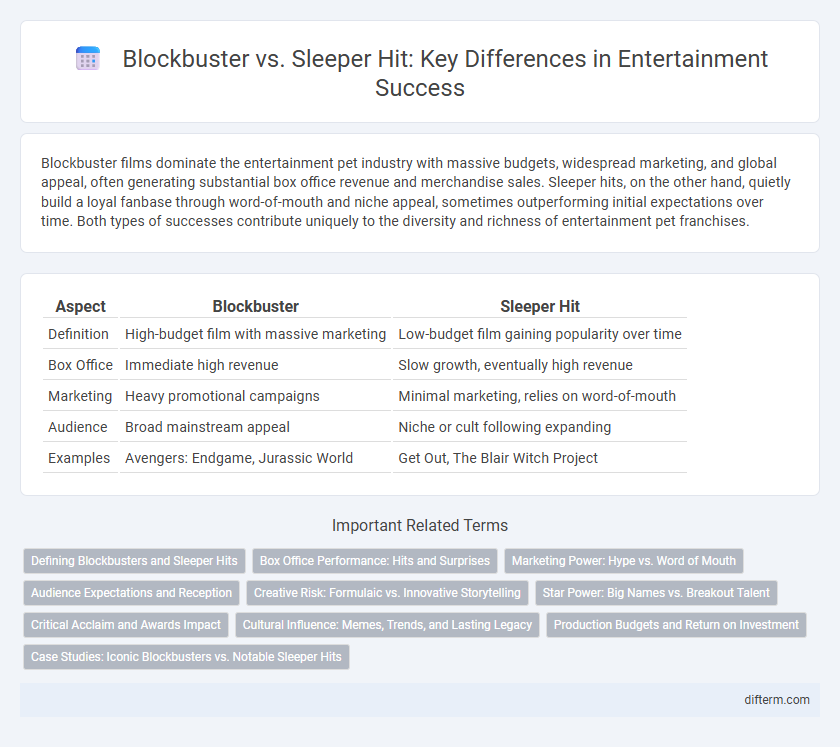Blockbuster films dominate the entertainment pet industry with massive budgets, widespread marketing, and global appeal, often generating substantial box office revenue and merchandise sales. Sleeper hits, on the other hand, quietly build a loyal fanbase through word-of-mouth and niche appeal, sometimes outperforming initial expectations over time. Both types of successes contribute uniquely to the diversity and richness of entertainment pet franchises.
Table of Comparison
| Aspect | Blockbuster | Sleeper Hit |
|---|---|---|
| Definition | High-budget film with massive marketing | Low-budget film gaining popularity over time |
| Box Office | Immediate high revenue | Slow growth, eventually high revenue |
| Marketing | Heavy promotional campaigns | Minimal marketing, relies on word-of-mouth |
| Audience | Broad mainstream appeal | Niche or cult following expanding |
| Examples | Avengers: Endgame, Jurassic World | Get Out, The Blair Witch Project |
Defining Blockbusters and Sleeper Hits
Blockbusters are high-budget films backed by extensive marketing campaigns, designed to generate massive box office revenue and widespread media attention upon release. Sleeper hits, by contrast, start with modest expectations and limited promotion but gradually gain popularity through positive word-of-mouth and critical acclaim. The key distinction lies in initial impact and marketing scale: blockbusters dominate opening weekends, while sleeper hits build success over time.
Box Office Performance: Hits and Surprises
Blockbuster films dominate box office performance with massive budgets, star-studded casts, and extensive marketing campaigns that drive opening weekend success and generate hundreds of millions worldwide. Sleeper hits, often low-budget or lesser-known titles, achieve unexpected box office success through strong word-of-mouth, critical acclaim, and viral social media buzz, sometimes surpassing initial projections. The contrast highlights how marketing strategies and audience reception shape financial outcomes, with blockbusters relying on scale and sleepers on organic growth.
Marketing Power: Hype vs. Word of Mouth
Blockbusters leverage extensive marketing power to create massive hype, utilizing high-budget trailers, star-studded premieres, and widespread advertising campaigns to ensure immediate mass appeal. In contrast, sleeper hits rely primarily on organic word of mouth, gaining traction gradually through audience recommendations and social media buzz rather than upfront promotional spending. The effectiveness of each strategy impacts box office longevity, with blockbusters often seeing strong initial numbers and sleeper hits experiencing sustained growth over time.
Audience Expectations and Reception
Blockbuster films often generate massive hype and high audience expectations due to extensive marketing campaigns and star-studded casts, typically resulting in large opening weekend box office numbers. Sleeper hits, however, rely on strong word-of-mouth and positive audience reception over time, often surpassing initial modest projections without heavy promotional efforts. The contrast in reception highlights how audience anticipation influences early performance, while sustained engagement determines long-term success.
Creative Risk: Formulaic vs. Innovative Storytelling
Blockbusters often rely on formulaic storytelling with proven tropes and high-budget effects to attract mass audiences, minimizing creative risk. Sleeper hits embrace innovative storytelling, presenting unique narratives and fresh perspectives that may initially underperform but ultimately gain critical acclaim through word-of-mouth. This contrast in creative risk shapes the market dynamics, with blockbusters prioritizing broad appeal and sleeper hits fostering originality in entertainment content.
Star Power: Big Names vs. Breakout Talent
Blockbuster films leverage star power with established actors whose names drive massive box office draws and wide audience anticipation. Sleeper hits often rely on breakout talent, introducing fresh faces whose performances create authentic buzz and organic word-of-mouth growth. The contrast highlights how big names provide immediate visibility, while emerging actors contribute to surprising success through compelling storytelling and audience connection.
Critical Acclaim and Awards Impact
Blockbuster films often secure widespread critical acclaim by combining high production values with star-studded casts, leading to significant awards visibility, particularly in major categories like visual effects and sound design. Sleeper hits, despite modest budgets and initial box office performance, frequently achieve critical praise through compelling storytelling and originality, garnering prestigious awards that enhance their long-term cultural impact. The awards impact of blockbuster versus sleeper hit films reflects distinct strategies: blockbusters leverage spectacle for mass appeal, while sleeper hits gain prestige through unique narratives recognized by critics and award bodies.
Cultural Influence: Memes, Trends, and Lasting Legacy
Blockbusters generate widespread buzz and cultural influence through high-profile marketing, spawning memes and trends that dominate social media and popular culture upon release. Sleeper hits often achieve a lasting legacy by gradually building devoted fanbases and inspiring niche memes that sustain cultural relevance over time. Both types shape entertainment landscapes, with blockbusters driving immediate cultural phenomena and sleeper hits fostering enduring, grassroots engagement.
Production Budgets and Return on Investment
Blockbuster films typically have high production budgets, often exceeding $100 million, aiming for massive global box office returns and extensive marketing campaigns. Sleeper hits, by contrast, operate with modest budgets under $20 million but achieve significant return on investment through strong word-of-mouth and gradual audience growth. The financial dynamics highlight that while blockbusters rely on large upfront expenditures and widespread distribution, sleeper hits generate impressive profits relative to their low-cost investments.
Case Studies: Iconic Blockbusters vs. Notable Sleeper Hits
Iconic blockbusters like "Avengers: Endgame" dominate global box offices with massive budgets, star-studded casts, and extensive marketing campaigns, generating over $2.798 billion worldwide. In contrast, notable sleeper hits such as "Get Out" achieved critical acclaim and cultural impact through modest budgets and grassroots promotion, grossing $255 million primarily via word-of-mouth. These case studies reveal how blockbuster strategies rely on scale and spectacle, while sleeper hits capitalize on originality and audience engagement to drive success.
blockbuster vs sleeper hit Infographic

 difterm.com
difterm.com